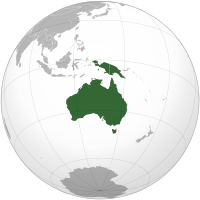Australia (continent)
 |
|
| Area | 8,600,000 km2 (3,300,000 sq mi) (7th) |
|---|---|
| Population | 36,000,000 (estimated population of Australia, Papua New Guinea, Papua, West Papua, Maluku Islands, Timor, Halmahera, etc. for 2009, 6th) |
| Pop. density | 4.2/km2 (11/sq mi) |
| Demonym | |
| Countries | 4 (Australia, Papua New Guinea, East Timor* and portions of Indonesia) |
| Languages | English, Indonesian, Tok Pisin, Hiri Motu, 269 indigenous Papuan and Austronesian languages, Mandarin Chinese, Italian, Arabic, Greek, Cantonese and about 70 Indigenous Australian languages |
| Time zones | GMT+10, GMT+9.30, GMT+8 |
| Internet TLD | .au, .pg, .tl, .tp and .id |
| Largest cities |
List of cities in Australia by population List
|
List of cities in Australia by population
List of cities and towns in Papua New Guinea by population
Australia, sometimes known in technical contexts by the names Sahul, Australinea or Meganesia, to distinguish it from the Australian mainland, is a continent comprising mainland Australia, Tasmania, New Guinea, Seram, possibly Timor, and neighbouring islands.
It is the smallest of the seven traditional continents in the English conception. The continent lies on a continental shelf overlain by shallow seas which divide it into several landmasses—the Arafura Sea and Torres Strait between mainland Australia and New Guinea, and Bass Strait between mainland Australia and Tasmania. When sea levels were lower during the Pleistocene ice age, including the Last Glacial Maximum about 18,000 BC, they were connected by dry land. During the past 10,000 years, rising sea levels overflowed the lowlands and separated the continent into today's low-lying arid to semi-arid mainland and the two mountainous islands of New Guinea and Tasmania. Geologically, a continent extends to the edge of its continental shelf, so the now-separate islands are considered part of the continent. Due to the spread of animals, fungi and plants across the single Pleistocene landmass the separate lands have a related biota.
New Zealand is not part of the continent of Australia, but of the separate, submerged continent of Zealandia. New Zealand and Australia are both part of the wider regions known as Australasia and Oceania. The term Oceania is often used to denote the region encompassing the Australian continent and various islands in the Pacific Ocean that are not included in the seven-continent model.
...
Wikipedia
